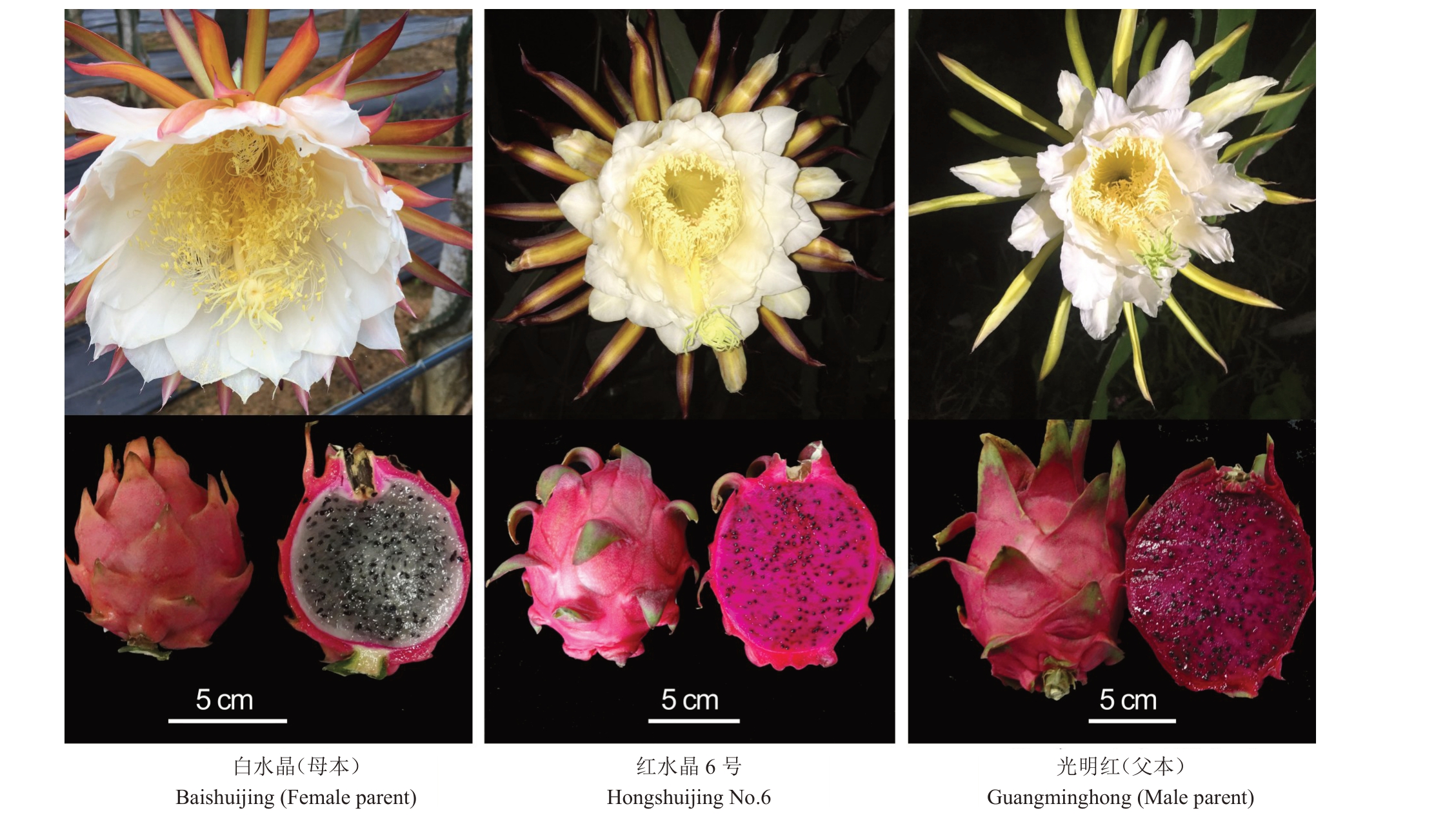火龙果为仙人掌科(Cactaceae)蛇鞭柱属(Selenicereus)植物,中国南方大部分地区均可栽培,在北方地区亦可大棚种植,近几年栽培面积呈指数型增长,全国栽培面积已经超过15 万hm2[1]。中国大陆地区火龙果栽培历史短,大量民间引种,来源不清晰,而且一些品种不完全适应中国的气候条件或存在缺陷,导致中国生产的火龙果果品质量良莠不齐,市场竞争力低[2]。为选育出适合本土气候和土壤条件且具有自主知识产权的优质火龙果新品种,使用2 个市场接受度高的优质品种白水晶与光明红[3]进行杂交,对杂交子一代优选,获得一个优株,经品种比较试验和区域试验,形成新株系。该株系果实近圆球形,平均单果质量295.0 g,果皮红色,果肉紫红色,肉质爽滑、风味甘甜。经多年多点试验试种,遗传性状稳定,丰产且品质优良,在火龙果产区均可种植。2018 年通过广东省农作物品种审定委员会审定,编号为粤审果20180004,审定名为红水晶6号。
1 选育过程
1.1 亲本选择
选择优良品种白水晶为母本,光明红为父本。其中白水晶果肉白色透明,甜度高,品质极佳,但果实小,产量低,成熟果皮带刺,生产上作为高端水果进行小面积商业化种植;父本光明红果肉红色,果实大,产量高,综合性状优良,但果实品质相对较差,是大陆地区广泛栽培的品种之一。父母本具有优势互补的特点,其中母本白水晶为自交不亲和品种,自交完全不结实,能保证F1子代为真杂种。
1.2 选育流程
1998 年广州大丘有机农产有限公司以白水晶为母本,光明红为父本进行人工杂交,获得约3000粒杂交种子播种于苗床,选取2000个长势健壮单株大田移栽,株高30 cm时从老熟单株上剪取接穗,嫁接于选种圃中(砧木为普通白肉火龙果),成活1560个单株,2000 年开始陆续挂果,对不同单株进行生长习性、适应性、丰产性、抗逆性以及果实经济性状等持续调查,至2007 年,从中初步筛选出12 个优良单株。其中,编号为S5-906 的单株表现为品质好、丰产、稳产、农艺性状稳定。2009—2012 年扩繁后于广州从化、东莞市望牛墩镇、江门市江海区礼乐镇开展区域和生产试验。严格按照果树育种规程,经多年多点观察分析,该品系均表现出适应性强、丰产、稳产,单果质量显著大于母本,品质与母本相当、且明显优于父本,口感好,遗传性稳定,暂命名为红水晶6号(图1)。

图1 火龙果新品种红水晶6 号及亲本
Fig.1 The new pitaya cultivar Hongshuijing No.6 and the parents
2 主要性状
2.1 植物学性状
红水晶6 号火龙果枝条多数为四棱形,幼茎肋缘略微下凹,老熟后肋缘趋于平齐。幼茎浅绿色,茎肋缘淡红色明显,随着茎的老熟,茎肋缘红色褪去,转为深绿色。幼嫩枝条刺座上布满白色短小茸毛,老熟枝条刺座含有1~3 个刺,刺暗褐色,刺长0.2~0.4 cm。花冠大,花被平均长13.5 cm,宽5.8 cm;心皮长14.8 cm,宽2.6 cm。花瓣白色,萼片主色橙红色,边缘红色,花柱长22.8 cm,柱头裂片24~30 个,黄绿色。果实近圆球形,平均纵径8.5 cm,平均横径8.4 cm。果皮红色,厚0.28 cm,鳞片外翻,中部鳞片宽度2.0 cm,基本鳞片短小略退化。
2.2 果实性状
果实近圆形,平均单果质量295.0 g。种子黑色、小而柔,果肉紫红色,肉质清爽、清甜,口感极佳,品质稳定。可溶性固形物含量、可滴定酸含量(w)均值分别为14.2%、0.19%。
2.3 产量性状
正常管理条件下,扦插苗定植后第2 年开始结果,5年后产量稳定。2~5年生单株平均产量为1.7、3.5、4.6、5.2 kg;折合每666.7 m2产量726.0、1 557.6、2 024.0、2 288.0 kg。
2.4 物候期
广州从化地区,每年开花10~12 批次,集中在5月底至10月下旬。每年有4次大批量花集中开放,分别为6 月初、7 月初、9 月初和10 月初。从现蕾到开花16~18 d,花朵于19:00 逐渐开放,20:00 完全绽放,第2 天早上慢慢闭合萎蔫,每批花期4 d。从开花至果实成熟随季节变化需要28~40 d。第一批果6月底成熟,最后一批果12月底成熟。
2.5 耐贮性
红水晶6号火龙果常温下可以保存7~9 d,低温冷藏可存放20~30 d,优于父本光明红的5~8 d 和15~20 d,和母本白水晶相当,耐贮性好。
2.6 溃疡病抗性
溃疡病是火龙果的主要病害,比较红水晶6 号火龙果和双亲对溃疡病的抗、感病程度,根据病情分级标准[4]划分病级数,进而计算出病情指数。抗感病情况分为5个级别:免疫(0)、高抗(>0~20)、中抗(>20~40)、感病(>40~60)、高感(>60)[4]。每个处理30个枝条,设置3次重复,以红水晶6号火龙果为对照进行双尾T 检验,从表1 可以看出,红水晶6 号火龙果对溃疡病表现为中抗,显著优于父母本(p<0.01)。
表1 红水晶6 号与双亲品种对火龙果溃疡病田间抗性评价
Table 1 Evaluation of field resistance of Hongshuijing No.6 and biparental varieties to pitaya canker disease

注:**表示双亲品种的发病率和病情指数与红水晶6 号差异极显著(p<0.01)。
Note:**indicates that the incidence and disease index of both parents were extremely significantly different from that of Hongshuijing No.6(p<0.01).
抗性评价Resistance evaluation中抗Moderate Resistance高感Highly Susceptible感病Susceptible品种Cultivar红水晶6号Hongshuijing No.6光明红Guangminghong白水晶Baishuijing发病率Incidence rate/%15.60病情指数Disease index 30.70 52.36**70.45**30.00**50.45**
3 栽培技术要点
3.1 适宜区域
红水晶6号火龙果树体生长势较强、易管理,在火龙果产区均可种植,宜选择有机质丰富、肥水条件好、排灌方便的地方建园。
3.2 栽培管理
定植幼苗主茎及时绑在支撑柱上。主茎达到支撑架顶端及时摘心,选留略低于支撑架或与支撑架相平的侧芽4~5条,作为一级分枝。当枝条长到50 cm以上时摘心,在一级分枝上促发并保留5 条左右二次枝。二次枝长到一定长度时会自然下垂,形成结果枝。进入结果期后,及时剪去新芽,并做好采果后修剪工作,剪除老枝、弱枝、下垂近地面及过密枝条。
3.3 花果管理
合理疏花疏果,以提高单果质量和品质,成熟期适时采收。生产中需种植其他品种作为授粉品种,种植比例为20∶1,即每20株红水晶6号火龙果搭配种植1株授粉品种。开花期利用授粉品种花粉对其进行人工授粉,以确保产量。
3.4 肥水管理
红水晶6号火龙果根系较浅,生长迅速,种植后8~12 个月即可挂果,生产上需要保证肥水供应,薄肥勤施。幼年树以施氮肥为主,成龄树以施磷、钾肥为主,控制氮肥用量,进入挂果期的成年树,应加强肥水管理,及时整形修剪。每年7月、10月和翌年3月,每株施有机肥4~5 kg、复合肥150~200 g。开花结果期间增施钾肥、镁肥、过磷酸钙,以促进果实糖分积累,改善品质。干旱季节每2~3 d 灌溉1 次,雨天注意排涝。
3.5 病虫害防治
易受蜗牛、蚂蚁、蛾类、蝶类幼虫危害,高温高湿季节易感染真菌病害。综合应用化学、物理及生物防治手段,减少化学用药量。对火龙果主要病害溃疡病表现出中度抗性,该病害以预防为主,一旦暴发,需要及时修剪、清理病枝与病果,结合化学防治,同时秋冬季及时清园。
[1] 李俊成,戴宏芬,孙清明.火龙果响应盐旱胁迫转录组分析[J].分子植物育种,1-11[2022-07-28].http://kns.cnki.net/kcms/detail/46.1068.S.20211222.0906.004.html.LI Juncheng,DAI Hongfen,SUN Qingming.Transcriptomic analysis of pitaya response under salinity or drought stress[J].Molecular Plant Breeding,1-11[2022-07-28].http://kns.cnki.net/kcms/detail/46.1068.S.20211222.0906.004.html.
[2] 郑伟,王彬,蔡永强,潘玺,张永忠,苏州,姜鹏,简学群.火龙果新品种‘黔果2 号’[J].园艺学报,2016,43(11):2285-2286.ZHENG Wei,WANG Bin,CAI Yongqiang,PAN Xi,ZHANG Yongzhong,SU Zhou,JIANG Peng,JIAN Xuequn.A new red fleshed pitaya cultivar‘Qianguo 2’[J].Acta Horticulturae Sinica,2016,43(11):2285-2286.
[3] 刘继伟.北京地区日光温室火龙果引种栽培试验研究[D].杨凌:西北农林科技大学,2015.LIU Jiwei.Study on the introduction cultivation of the pitaya in greenhouse of Beijing area[D].Yangling:Northwest A& F University,2015.
[4] 卢芳.火龙果溃疡病抗病性鉴定方法及抗病种质资源筛选研究[D].广州:华南农业大学,2016.LU Fang.Establishing the methods of pitaya canker disease resistance identification and selection of resistance resources[D].Guangzhou:South China Agricultural University,2016.